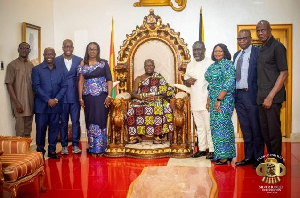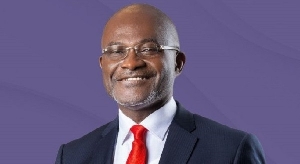- Home - News
- TWI News | TV
- Polls
- Year In Review
- News Archive
- Crime & Punishment
- Politics
- Regional
- Editorial
- Health
- Ghanaians Abroad
- Tabloid
- Africa
- Religion
- Election 2020
- Coronavirus
- News Videos | TV
- Photo Archives
- News Headlines
- Press Release
Business News of Friday, 16 September 2011
Source: Abdul Hakim Ahmed, Media Liaison, Ministry of Finance And Economic Planning
The State of the Ghanaian Economy
The economy of Ghana experienced a high level of macroeconomic instability in 2008 and in the first half of 2009. By the end of June 2009, inflation rate had reached a peak of 20.74 per cent from 12.81 per cent in January 2008, generating annual inflation rate of 19.3 per cent in 2009. The cedi also depreciated against the US dollar by 50 per cent from January 2008 to June 2009. This macroeconomic instability was caused by the fiscal slippage of 2008 that resulted in a fiscal deficit of 14.5 per cent of the GDP (equivalent to about 9.4 percent of the rebased GDP). Additionally, 2008 saw a huge current account deficit of US$3,532.2 million. As a result, gross international reserves reduced from 3.0 months of imports cover as at the end of 2006 to only 2.1 months of imports cover as at the end of 2008. Because of these negative developments, the NDC Government had to adopt austerity measures to bring sanity into the macroeconomic environment when it took office in January 2009. It is therefore not surprising that real GDP only grew by 4.0 per cent in 2009.
However, due to the prudent fiscal and macroeconomic management strategies put in place by Government as part of the Better Ghana Agenda, the economy quickly recovered, and it is currently enjoying a great deal of macroeconomic stability accompanied by accelerated economic growth.
The Real Sector Performance
Real GDP growth rate increased from 4.0 per cent in 2009 to 7.7 per cent in 2010. Quarterly GDP data released by the Ghana Statistical Service (GSS) show that even though relative to the last quarter of 2010, real GDP declined by 5.1 per cent in the first quarter of 2011 on the account of weaker performance of the agricultural sector due to the seasonality of the sector’s production pattern, on year-on-year basis, the first quarter of 2011 recorded an impressive growth rate of 23.0 per cent. This is much better than the year-on-year growth rate of 6.7 per cent recorded in the first quarter of 2010. The impressive year-on-year real GDP growth in the first quarter of 2011 was driven by crops (mainly cocoa), mining and quarrying, manufacturing, construction, transport and storage and business service activities.
The Bank of Ghana’s Composite Index of Economic Activities (CIEA) also showed a real growth rate of 20.5 per cent on year-on-year basis for the first half of 2011.
These data clearly show that Ghana is well on course to realize the projected real GDP growth rate of 14.1 per cent in 2011, putting the economy of Ghana as one of the fastest growing economies in the world in 2011.
Macroeconomic Stability
From June 2009 when it reached a peak of 20.74 per cent, inflation rate fell continuously over an eighteen month period to 8.58 per cent in December 2010. Even though inflation rate increased marginally to 9.08 per cent and 9.16 per cent in January and February 2011 respectively, it began to decline again starting from March 2011 pushing the inflation rate down to 8.39 per cent in July 2011.
After depreciating against the US dollar at the rate of 23.5 per cent from January to December 2008 and at the rate of 14.8 per cent from January to June 2009, the interbank exchange of the cedi to the US dollar has largely stabilized. For instance, from January to October 2010, the interbank exchange of the cedi to the US dollar stabilized around 1.43 cedis to 1 US dollar, after the cedi appreciated against the US dollar by 2.7 per cent from July to December 2009. Even though starting from November 2010 the cedi began to depreciate against the US dollar, which culminated in a 5 percent depreciation rate in January 2011, the exchange rate of the cedi has stabilized since then.
The External Sector Performance
The external sector of the economy has seen a lot of improvement since 2008. The current account deficit decreased from US$3,532.2 million in 2008 to US$1,598 million and US$2,594 million in 2009 and 2010 respectively. Also, the overall balance of the balance of payment improved from a deficit of US$940.9 million in 2008 to surpluses of US$1,158.9 million and US$1,462.7 million in 2009 and 2010 respectively. The first seven months of 2011 has again seen a good performance of the external sector as merchandise exports grew by 62.3 per cent driven by gold, cocoa beans and crude oil exports. This compares with merchandise imports growth of 45.4 per cent for the same period.
Fiscal and Monetary Policy Strategies
Indeed, the strong macroeconomic performance of the country’s economy is largely due to Government’s continuous pursuance of prudent macroeconomic management strategies. The expansionary fiscal stance of the previous administration leading to the huge budget and current account deficits was brought to an end in 2009. Government commitment to fiscal consolidation saw the overall budget deficit brought down to 5.7 percent and 5.9 percent of the GDP (rebased) respectively in 2009 and 2010. In 2011, Government is on track to achieve a deficit of about 5.1 percent of the GDP.
Monetary policy has also been carefully tailored to deepen the prevailing macroeconomic stability to enhance economic growth. Growth rate in the broad money supply (M2+), on year-on-year basis, decreased from an average of 37.6 percent in 2008 and 33.6 percent in 2009 to 28.7 percent from January to August 2010. Even though broad money supply shows signs of increasing at higher rates in recent months, this is on the account of increased foreign currency deposits.
Conclusion
It is clear from the foregoing analysis that the macroeconomic environment has been stabilized since the turbulence in 2008 and the first half of 2009. The performances of the real and external sectors of the economy have also substantially improved. It can therefore be concluded that the policies put in place by Government when it took office in January 2009 have yielded good fruits. However, since a lot more need to be done, Government is committed to stay focused in pursuit of the goals and objectives set out in the Better Ghana Agenda.











